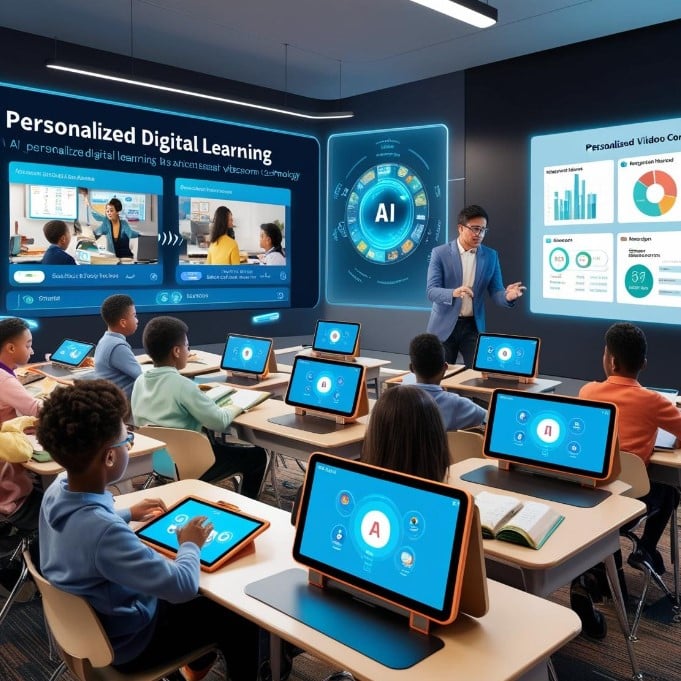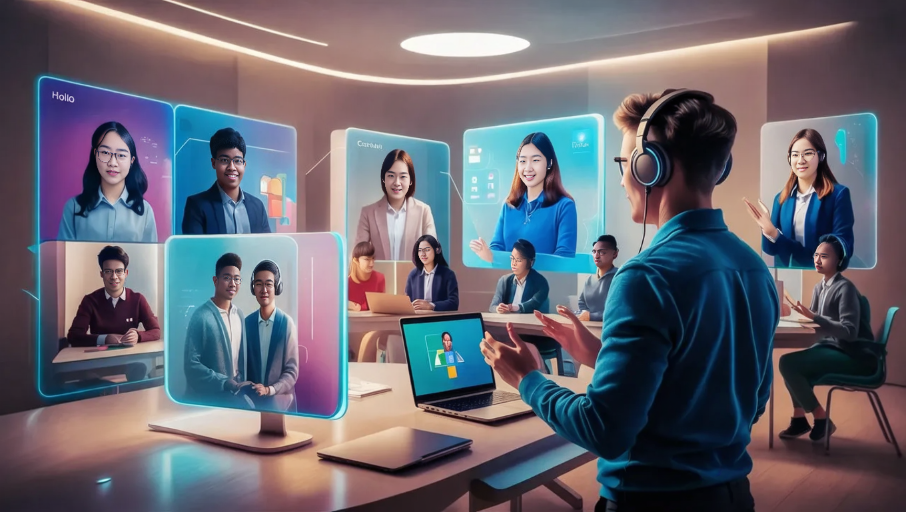Introduction
The COVID-19 pandemic turned the world upside down, and the education system was no exception. Schools and universities around the world had to pivot quickly from traditional face-to-face classrooms to remote learning. During this time, video conferencing became a vital tool, enabling educators to continue teaching through platforms like Microsoft Teams, Zoom, and Google Meet.
Online education has significantly expanded access to learning. A 2020 study revealed that over 1.2 billion students in 186 countries were affected by school closures due to COVID-19, and online education provided a solution for continuity (World Economic Forum, 2020). The ability to access courses remotely allowed students from various backgrounds to continue their education without interruption.
However, the shift to remote education wasn’t easy. Many challenges arose, from technical issues to maintaining student engagement.
In this blog, we will explore the role of video conferencing in remote learning, the challenges it presents, and how educators can improve the learning experience using these tools in the long term.

Initial Challenges in Remote Education
Lack of Face-to-Face Interaction
One of the biggest educational challenges was the loss of face-to-face interaction. In a traditional classroom, teachers and students can communicate directly, and feedback is immediate. With video conferencing, that personal touch is often missing, making it difficult for both students and teachers to engage in real-time discussions. The human connection that fosters learning was, to some extent, lost.
For younger students, this lack of interaction was particularly tough. Educational videos for kids can only go so far without the guidance of a teacher right there with them.
Technical Difficulties: Internet and Device Issues

Another major hurdle was the reliance on technology. The shift to online learning revealed the digital divide—the gap between those with access to reliable internet and devices and those without. Many students and teachers struggled with slow internet connections, poor audio and video quality, and outdated devices. These examples of educational challenges are a direct result of technological limitations.
In many rural or underserved areas, access to basic technology is still a challenge, and students there are at a significant disadvantage compared to those in more connected areas. “In a survey of undergraduate students who were forced to take online classes, 45% reported internet connectivity issues that interfered with their course participation” (Hanson, 2024).
Engagement and Interaction Issues
Keeping Students Engaged
Maintaining engagement in a virtual learning environment is another major challenge. In a traditional classroom, teachers use body language, eye contact, and movement around the room to hold students’ attention. With video calls, students are often left staring at a screen for long periods, which can be both tiring and distracting. Keeping students motivated and engaged in this setting is not easy.
Distractions at home—such as family, pets, or even the temptation to browse the web—make it harder for students to focus during a video meeting. The absence of peers also makes participation less spontaneous.
Real-Time Participation and Feedback
With video conferencing, there are often delays in real-time participation. Audio and video lags can make it harder for students to ask questions or join discussions without interruptions. This breaks the natural flow of learning and leads to frustration for both students and educators. In a face-to-face classroom, teachers can gauge understanding immediately, but remote education requires a more careful approach.
Video Conferencing Platform Limitations
Issues with Video Conferencing Software
While video conferencing platforms like Microsoft Teams are essential for remote education, they come with limitations. Video conferencing tools sometimes struggle to handle large groups, leading to technical glitches such as freezes and disconnects. This is particularly challenging during large team meetings or when multiple classes are running at the same time.
Many video conferencing platforms also lack features tailored to education. For example, some platforms don’t allow for personalised interactions or student-specific adjustments during a session. This limits the adaptability of teaching methods.
Audio and Video Lags
Technical problems such as audio and video lags can significantly affect the quality of the learning experience. When communication is disrupted, students may miss critical parts of the lesson. This can leave gaps in their understanding, which are harder to fill when working remotely. Consistent, high-quality audio and video are essential for effective online learning.
Learning Environment and Accessibility Concerns
Creating an Effective Virtual Learning Environment

A successful remote education experience relies on an effective learning environment at home. However, not all students have access to quiet study spaces or reliable mobile devices to participate in lessons. Many are sharing living spaces with family members, which can make it difficult to focus.
Additionally, the quality of the virtual learning environment can vary greatly depending on the tools and video conferencing platforms used. Students with better access to technology often have a more seamless experience, while those in underserved areas may struggle.
The Digital Divide: Access to Technology
The digital divide is a growing concern. Students in lower-income households or rural areas often lack the necessary equipment, such as a stable internet connection or updated devices. The divide between those who can access distance learning and those who cannot creates inequalities in education. This is a long-term problem that schools and governments must address to ensure fair access to education.
Addressing Psychological and Emotional Barriers
Isolation and Lack of Motivation
The emotional impact of remote education should not be overlooked. Many students have reported feelings of isolation, with limited interaction with their peers. The lack of socialisation can affect their mental health, making them feel less motivated to engage with the material.
Video chat does provide some level of connection, but it can’t fully replicate the emotional benefits of physical presence. The absence of a structured school day can also lead to a lack of routine, further decreasing motivation.
Burnout from Screen Time

With remote learning, students are spending extended hours in front of screens. Constant video meetings can lead to digital burnout, where students feel exhausted from long periods of screen time. This also affects their attention span and willingness to participate in future classes. To tackle this, educators need to balance online meetings with other types of learning activities.
The Way Forward: Overcoming Challenges
Long-Term Benefits of Evolving Technology

Despite these challenges, video conferencing work has brought several long-term benefits. It has introduced flexibility into education, enabling students to learn from anywhere. As conferencing platforms evolve, they will likely offer more features to improve student learning and engagement.
Improvements in video conferencing software and video learning tools could lead to more personalised education. For example, AI could be used to adapt lessons to individual student needs. By leveraging data from video conferencing tools, educators can better assess student performance and adjust their teaching methods accordingly.
Addressing the Digital Divide
Bridging the digital divide is crucial for the future of remote education. Schools and governments must work together to ensure that every student has access to the technology they need. This includes providing devices, offering better internet infrastructure, and creating a supportive virtual learning environment.
Conclusion
Video conferencing has transformed education during the COVID-19 pandemic, making remote learning possible. However, this shift has highlighted several challenges, including the lack of face-to-face interaction, technical difficulties, and issues with student engagement.
While there are still hurdles to overcome, the future of remote education looks promising. With evolving technology, educators can improve the learning environment and create a more inclusive, personalised experience for students. By addressing the digital divide and supporting mental health, schools can ensure that remote working and learning are as effective as traditional classrooms.
The long-term benefits of video conferencing in education are clear—it offers flexibility, accessibility, and new ways to engage with students. The key now is to refine these tools to meet the growing demands of the modern education system.
Continue reading: Video Communication: Connecting Cultures and Markets
References
-
Hanson, M. (2024, August 31). Cost of Online Education vs. Traditional Education [2024]: Comparison. Education Data Initiative. Retrieved October 2024.
-
World Economic Forum. (2020, April 29). The rise of online learning during the COVID-19 pandemic. The World Economic Forum. Retrieved October 2024.
